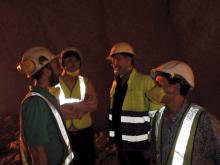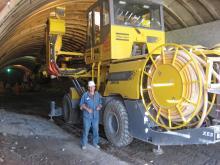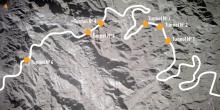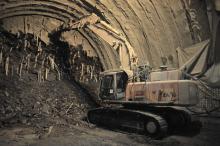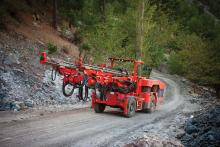Following the success of the 41st World Tunnel Congress held in Croatia last May, World Highways looks at two signi_ cant projects in Slovakia and Serbia – Adriana Potts reports
Central and Eastern Europe is buzzing with a number of major projects being developed - including highways, bridges and tunnels – and with many more in the pipeline.
The region is expected to be highly active with plans for developing infrastructure in the next two decades, according to Davorin Koli , president of the Croatian
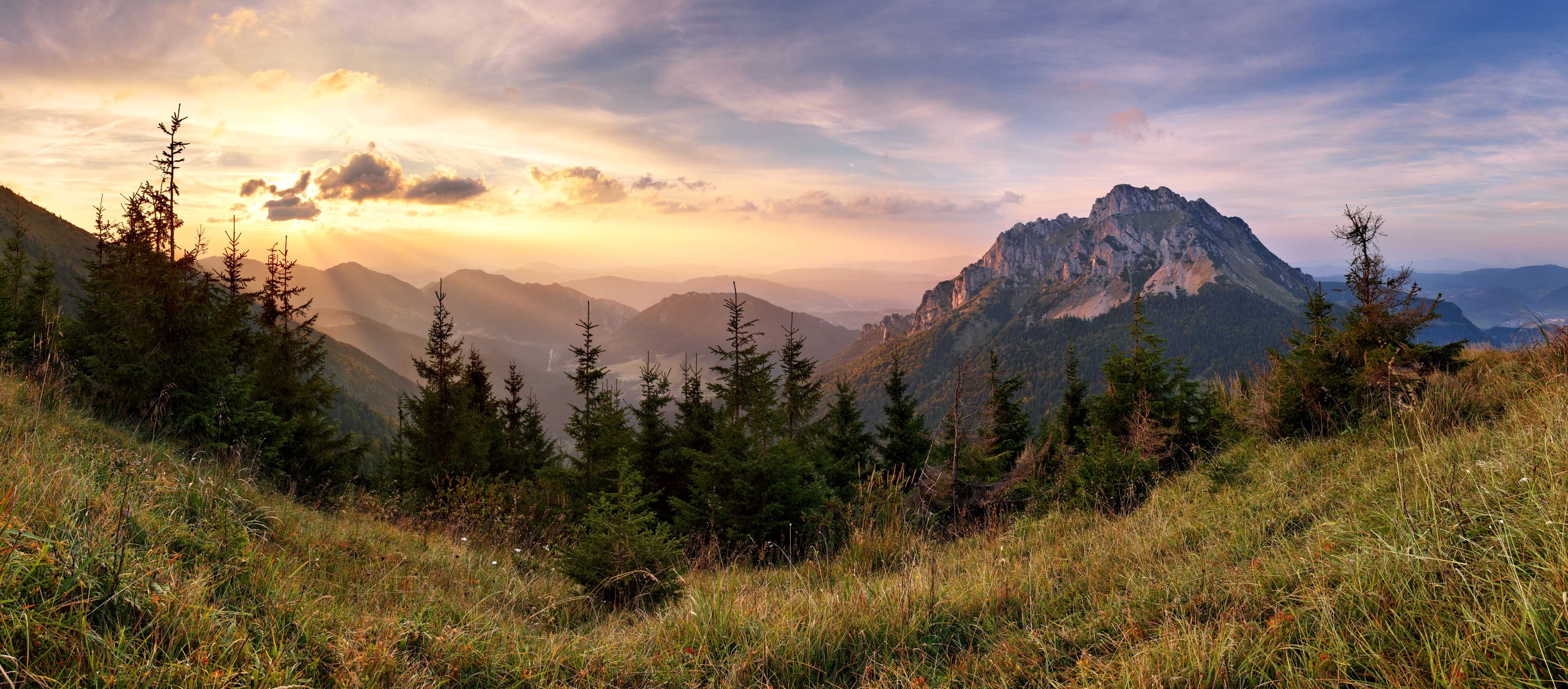
Serbia is undergoing significant development of its infrastructure network, which will help connect remote areas to urban centres
Following the success of the 41st World Tunnel Congress held in Croatia last May, World Highways looks at two significant projects in Slovakia and Serbia – Adriana Potts reports
Central and Eastern Europe is buzzing with a number of major projects being developed - including highways, bridges and tunnels – and with many more in the pipeline.
The region is expected to be highly active with plans for developing infrastructure in the next two decades, according to Davorin Koli, president of the Croatian Association for Tunnels and Underground Structures.
Slovakia is pressing well ahead with numerous investments in infrastructure: already four new tunnels are in use with a total length of 8,015km. There are currently eight tunnels under construction, with a total length of 16,727km. These include: Ovčiarsko, Žilina, Višnové, Šibenik and ebrat on the D1 highway, plus, Považský Chlmec, Svr inovec and Pol’ana on the D3 highway. Additionally, there are plans for a further 22 tunnels, representing a total length of 49,385km. In Serbia, now an EU candidate, Corridors 10 and 11 are very significant and have strategic importance for the country according to Zorana Mihajlovic, Serbian deputy prime minister and minister of construction, Transport and Infrastructure. Within these corridors there are several projects currently under development, including the Manajle, Predejane and Sarani tunnels.
Corridor 10 is one of the most important pan-European transport corridors that runs through Serbia and connects Austria, Hungary, Slovenia, Croatia, Serbia, Bulgaria, Macedonia and Greece. The project’s goal is to create a transport system in Serbia that is compatible with that of the European Union. This would result in an easier flow of international trade and passenger transport and an improvement in the level of service. It is expected that once finished, the highway system will have a positive influence in commerce and trade in the region and will contribute to the regional development and cohesion of the broader area of the Balkans
Slovakia: Ovčiarsko tunnel
The Ovčiarsko Tunnel is located in northern Slovakia on the D1 highway, between the cities of Bytča and Žilina. The D1 highway is part of the E 50 international transport route leading from Paris via Nuremberg and Prague through Ukraine to Russia.
Ovčiarsko is one of the two tunnels (the other one being the Žilina tunnel) that form part of a €427 million contract to build an approximately 11km section of the D1 highway. Apart from the tunnels, the construction works comprise eleven bridges and numerous access roads. The order for the whole section was assigned to a consortium of four partner companies:2877 Doprastav (32%), 945 STRABAG (32%), Váhostav (32%) and Metrostav (4%). Doprastav is specifically tasked with the tunnels and, through construction management company EKOFIN, it has subcontracted Uranpres for the construction work.
Ladislav Grega, Ovčiarsko’s construction manager, gives details about the tunnel: Under construction since July 2014 and with plans to open in January 2018, Ovčiarsko is a twin-track tunnel with a length of 2,367km. The tunnel is being driven simultaneously from portals at the east and west ends. Currently about 50% of the excavation has been completed. In the west portal, about 1km of tunnel has been driven in the north tube and about 900m in the south tube. “Work at the eastern portal has been slower; we stopped soon after it started due to geotechnical problems,” Grega said, adding that work only resumed in March/April this year. So far, about 300m has been driven in the north tube and about 100m in the south tube from the eastern portal.
“From a geological point of view, this is one of the most difficult tunnel construction projects in Slovakia,” said Igor Jurík, project geologist at Ovčiarsko. He explained that the northern part of the country is very mountainous and that weak or soft rocks, in particular a type of clay named Flysh, are often found in the Slovak part of the Western Carpathians. The weak rock is so common that it is practically impossible to avoid in engineering constructions and, as it happens, Ovčiarsko is being developed in mostly Flysh geology. Jurik said, “We have two types of geological units in the tunnel, an older unit with rigid rock which is not bad to work with and a younger unit with the Flysh-type rock, which is a nightmare to work with.” The weak rock has low strength, high porosity, disintegrates in contact with water, swells and has low durability. A challenge if ever there was one. The rock has been classified as poor, between 4-X-F and 5-XF in the excavation class according to the Austrian standard O-Norm B2203/1994.
The geological units are not consistent throughout the tunnel, they vary substantially and frequently. From the western portal, the first 300m is in the older geological unit so the rock was geotechnically stable enough to work with. After that the geology varies every few metres forcing the company to employ different methods: drill & blast in the more competent, harder rock and hydraulic hammer and excavation in the poor quality soft rock. But the real challenge is doing this every few metres – with the required changeover of equipment and crew. In a single production cycle, tunnel advance could be anything from 0.5-2.5m. “The right technology has to be used depending on the geology and so it’s not possible to use just one method throughout the whole tunnel, we have to adapt to what we find,” said Jozef Valko, senior construction manager and who has over 20 years of experience in tunnel construction around Europe. As he says, and knows very well, the geology situation places high financial demands and technical challenges on the project.
Of course the company knew this from the beginning, when planning studies and an exploration gallery were started. “We expected the worst,” Valko said, explaining that they first expected to use drill and blast for only about 20-25% of the tunnel. However, with the development so far done, this figure has gone up to about 50%. This is good news for the advance of the tunnel in general.
For drilling and blasting of the tunnel face in the better rock, Uranpres uses two Boomer E2 C drilling rigs equipped with COP 3038 rock drills. The rigs are also employed in portal stabilisation work using the Atlas Copco Secoroc Symmetrix system. This method involves steel pipes or casings installed in an umbrella pattern in the crown of the tunnel, providing support ahead of drilling and blasting. As well as rock bolting and shotcreting, wire mesh and lattice work are also employed as stabilisation techniques.
The company works seven days a week with two shifts of 12 hours/day. As tradition demands, a figure of Saint Barbara, patron saint of tunnellers and miners has been placed at both sides of the tunnel, bearing witness to a job well done in the midst of challenging conditions.
Serbia: Manajle & Predejane
In order to improve its transport and infrastructure network, several substantial construction projects are currently underway in Serbia. One of the key projects is the construction of the Manajle and Predejane tunnels on the Grabovnica-Levosoje section of the E75 highway. This is the most important traffic corridor in the Serbian transport network as it connects significant social and economic centres in the northern and southern parts of the country. The E75 highway spans approximately 600km crossing the country from the border with Hungary in the north to the border with Macedonia in the south. More specifically, the tunnels are located within the Pan European Corridor 10 in the south of the country between the Serbian city of Nish and the Macedonian border.
The project’s main objective is to improve traffic flow on Corridor 10 as well as to bring the environmental and safety standards of the road network, into line with EU standards. This is very important for Serbia as the country is seeking to become a full member of the European Union.
Financed by a loan from the European Investment Bank, the project has an overall budget of over €50 million, of which €2.5 million comes from the Instrument for Pre-Accession Assistance of the European Union. The employer is the state company3235 Koridori Srbije.
The whole project is being built by a consortium called Alliance 10, formed by specialist Bulgarian tunnel construction company Euro Alliance Tunnels, the main partner with 95% of participation and, Roads & Bridges, also from Bulgaria and responsible for building the corresponding roads and bridges.
The Tunnels
At 1.8km long, the Manajle tunnel will be the longest road tunnel in Serbia. It will have two tubes, one for each direction of traffic, with two lanes in each. The right tube will be 1.8km long and the left tube will be 1.808km long. Ten kilometres further north from here and being built by the same management team, is Predejane, also a twin-tube, two-lane tunnel. Here, one tube will be 870m long and the other tube will be 1.05km long. Both tunnels will feature an emergency lane between the two tubes.
As in Slovakia, the image of a patron saint was placed at the portal of each tunnel at the start of construction. However in Serbia, instead of Saint Barbara, it is Saint John of Rila, the one in charge of protecting tunnel workers.
Both project sites, which work 24 hours a day with two shifts of 12 hours each, have a combined workforce of 170 people. According to Stojan Petrovski, general project manager for both tunnels, most workers are from Bulgaria and about 90% of them are skilled.
“It’s difficult to find skilled workers here so we brought our own. They have experience working on similar projects.” He explained that with so many construction projects going on in the region and with the difficulty in finding skilled workers, one of the company’s priorities is to keep its workers happy and to retain them. Although there is no formal training programme in place, the operators do receive the required training from providers when a new machine arrives. For instance, when a new E2 C drilling rig arrived, Atlas Copco trained the operators in the use of the machine and its RCS 5 computerised system.
Preparation work started in September 2013 and the plan is for the tunnels to be finished in March 2016. “So far we’ve developed about 50% of the tunnels but we’re not exactly on schedule right now as we’ve found that the geological conditions are more complex than we first anticipated,” said Petrovski. Just like in Slovakia, the type of rock here also presents a challenge: “It’s not even proper rock, it’s clay!” said Petrovski, explaining that they use the New Austrian Tunnelling Method (NATM) for development, a popular method of modern tunnel design and construction that provides an optimised support based on observed ground conditions, so it can be described as a ‘design as you monitor’ approach.
In case of a weaker rock mass the use of pipe roofing is required for crown support, which in turn leads to less overbreak as well as ensuring safety during work.
The variability of the rock environment at these tunnels requires frequent changes of the driving technology – hydraulic hammer and excavator in weak rock and drilling and blasting in hard rock.
According to the original project study for Manajle and Predejane, the company was expecting to employ mostly drill and blast: “Drill and blast is much faster of course but we’ve been forced by the conditions to work with hydraulic hammers and excavators whenever we encounter bad rock, which makes progress slower,” said Petrovski explaining that advance depends completely on the geology they find. In good geology, advance can be about 3m in one shift of 12 hours. “We don’t necessarily see this as a huge problem, this is the situation we found and we just have to deal with it.”
Velin Mahov, construction manager for both projects, explains that drilling in the good rock in both tunnels is carried out by Boomer E2 C and L2 C rigs and that when working in bad rock, the company employs HB 1700 hydraulic breakers mounted on a hydraulic crawler excavator. When working in bad geology, the rigs are also used to install pipes in an umbrella pattern.
Euro Alliance is a large company and right now, apart from Serbia, it is active in tunnel construction projects in several countries; they are driving four tunnels in Germany, two tunnels in Spain and two tunnels in Bulgaria.
Note: A version of this article appears in the161 Atlas Copco Mining & Construction magazine, No 1, 2015.
Central and Eastern Europe is buzzing with a number of major projects being developed - including highways, bridges and tunnels – and with many more in the pipeline.
The region is expected to be highly active with plans for developing infrastructure in the next two decades, according to Davorin Koli, president of the Croatian Association for Tunnels and Underground Structures.
Slovakia is pressing well ahead with numerous investments in infrastructure: already four new tunnels are in use with a total length of 8,015km. There are currently eight tunnels under construction, with a total length of 16,727km. These include: Ovčiarsko, Žilina, Višnové, Šibenik and ebrat on the D1 highway, plus, Považský Chlmec, Svr inovec and Pol’ana on the D3 highway. Additionally, there are plans for a further 22 tunnels, representing a total length of 49,385km. In Serbia, now an EU candidate, Corridors 10 and 11 are very significant and have strategic importance for the country according to Zorana Mihajlovic, Serbian deputy prime minister and minister of construction, Transport and Infrastructure. Within these corridors there are several projects currently under development, including the Manajle, Predejane and Sarani tunnels.
Corridor 10 is one of the most important pan-European transport corridors that runs through Serbia and connects Austria, Hungary, Slovenia, Croatia, Serbia, Bulgaria, Macedonia and Greece. The project’s goal is to create a transport system in Serbia that is compatible with that of the European Union. This would result in an easier flow of international trade and passenger transport and an improvement in the level of service. It is expected that once finished, the highway system will have a positive influence in commerce and trade in the region and will contribute to the regional development and cohesion of the broader area of the Balkans
Slovakia: Ovčiarsko tunnel
The Ovčiarsko Tunnel is located in northern Slovakia on the D1 highway, between the cities of Bytča and Žilina. The D1 highway is part of the E 50 international transport route leading from Paris via Nuremberg and Prague through Ukraine to Russia.
Ovčiarsko is one of the two tunnels (the other one being the Žilina tunnel) that form part of a €427 million contract to build an approximately 11km section of the D1 highway. Apart from the tunnels, the construction works comprise eleven bridges and numerous access roads. The order for the whole section was assigned to a consortium of four partner companies:
Ladislav Grega, Ovčiarsko’s construction manager, gives details about the tunnel: Under construction since July 2014 and with plans to open in January 2018, Ovčiarsko is a twin-track tunnel with a length of 2,367km. The tunnel is being driven simultaneously from portals at the east and west ends. Currently about 50% of the excavation has been completed. In the west portal, about 1km of tunnel has been driven in the north tube and about 900m in the south tube. “Work at the eastern portal has been slower; we stopped soon after it started due to geotechnical problems,” Grega said, adding that work only resumed in March/April this year. So far, about 300m has been driven in the north tube and about 100m in the south tube from the eastern portal.
“From a geological point of view, this is one of the most difficult tunnel construction projects in Slovakia,” said Igor Jurík, project geologist at Ovčiarsko. He explained that the northern part of the country is very mountainous and that weak or soft rocks, in particular a type of clay named Flysh, are often found in the Slovak part of the Western Carpathians. The weak rock is so common that it is practically impossible to avoid in engineering constructions and, as it happens, Ovčiarsko is being developed in mostly Flysh geology. Jurik said, “We have two types of geological units in the tunnel, an older unit with rigid rock which is not bad to work with and a younger unit with the Flysh-type rock, which is a nightmare to work with.” The weak rock has low strength, high porosity, disintegrates in contact with water, swells and has low durability. A challenge if ever there was one. The rock has been classified as poor, between 4-X-F and 5-XF in the excavation class according to the Austrian standard O-Norm B2203/1994.
The geological units are not consistent throughout the tunnel, they vary substantially and frequently. From the western portal, the first 300m is in the older geological unit so the rock was geotechnically stable enough to work with. After that the geology varies every few metres forcing the company to employ different methods: drill & blast in the more competent, harder rock and hydraulic hammer and excavation in the poor quality soft rock. But the real challenge is doing this every few metres – with the required changeover of equipment and crew. In a single production cycle, tunnel advance could be anything from 0.5-2.5m. “The right technology has to be used depending on the geology and so it’s not possible to use just one method throughout the whole tunnel, we have to adapt to what we find,” said Jozef Valko, senior construction manager and who has over 20 years of experience in tunnel construction around Europe. As he says, and knows very well, the geology situation places high financial demands and technical challenges on the project.
Of course the company knew this from the beginning, when planning studies and an exploration gallery were started. “We expected the worst,” Valko said, explaining that they first expected to use drill and blast for only about 20-25% of the tunnel. However, with the development so far done, this figure has gone up to about 50%. This is good news for the advance of the tunnel in general.
For drilling and blasting of the tunnel face in the better rock, Uranpres uses two Boomer E2 C drilling rigs equipped with COP 3038 rock drills. The rigs are also employed in portal stabilisation work using the Atlas Copco Secoroc Symmetrix system. This method involves steel pipes or casings installed in an umbrella pattern in the crown of the tunnel, providing support ahead of drilling and blasting. As well as rock bolting and shotcreting, wire mesh and lattice work are also employed as stabilisation techniques.
The company works seven days a week with two shifts of 12 hours/day. As tradition demands, a figure of Saint Barbara, patron saint of tunnellers and miners has been placed at both sides of the tunnel, bearing witness to a job well done in the midst of challenging conditions.
Serbia: Manajle & Predejane
In order to improve its transport and infrastructure network, several substantial construction projects are currently underway in Serbia. One of the key projects is the construction of the Manajle and Predejane tunnels on the Grabovnica-Levosoje section of the E75 highway. This is the most important traffic corridor in the Serbian transport network as it connects significant social and economic centres in the northern and southern parts of the country. The E75 highway spans approximately 600km crossing the country from the border with Hungary in the north to the border with Macedonia in the south. More specifically, the tunnels are located within the Pan European Corridor 10 in the south of the country between the Serbian city of Nish and the Macedonian border.
The project’s main objective is to improve traffic flow on Corridor 10 as well as to bring the environmental and safety standards of the road network, into line with EU standards. This is very important for Serbia as the country is seeking to become a full member of the European Union.
Financed by a loan from the European Investment Bank, the project has an overall budget of over €50 million, of which €2.5 million comes from the Instrument for Pre-Accession Assistance of the European Union. The employer is the state company
The whole project is being built by a consortium called Alliance 10, formed by specialist Bulgarian tunnel construction company Euro Alliance Tunnels, the main partner with 95% of participation and, Roads & Bridges, also from Bulgaria and responsible for building the corresponding roads and bridges.
The Tunnels
At 1.8km long, the Manajle tunnel will be the longest road tunnel in Serbia. It will have two tubes, one for each direction of traffic, with two lanes in each. The right tube will be 1.8km long and the left tube will be 1.808km long. Ten kilometres further north from here and being built by the same management team, is Predejane, also a twin-tube, two-lane tunnel. Here, one tube will be 870m long and the other tube will be 1.05km long. Both tunnels will feature an emergency lane between the two tubes.
As in Slovakia, the image of a patron saint was placed at the portal of each tunnel at the start of construction. However in Serbia, instead of Saint Barbara, it is Saint John of Rila, the one in charge of protecting tunnel workers.
Both project sites, which work 24 hours a day with two shifts of 12 hours each, have a combined workforce of 170 people. According to Stojan Petrovski, general project manager for both tunnels, most workers are from Bulgaria and about 90% of them are skilled.
“It’s difficult to find skilled workers here so we brought our own. They have experience working on similar projects.” He explained that with so many construction projects going on in the region and with the difficulty in finding skilled workers, one of the company’s priorities is to keep its workers happy and to retain them. Although there is no formal training programme in place, the operators do receive the required training from providers when a new machine arrives. For instance, when a new E2 C drilling rig arrived, Atlas Copco trained the operators in the use of the machine and its RCS 5 computerised system.
Preparation work started in September 2013 and the plan is for the tunnels to be finished in March 2016. “So far we’ve developed about 50% of the tunnels but we’re not exactly on schedule right now as we’ve found that the geological conditions are more complex than we first anticipated,” said Petrovski. Just like in Slovakia, the type of rock here also presents a challenge: “It’s not even proper rock, it’s clay!” said Petrovski, explaining that they use the New Austrian Tunnelling Method (NATM) for development, a popular method of modern tunnel design and construction that provides an optimised support based on observed ground conditions, so it can be described as a ‘design as you monitor’ approach.
In case of a weaker rock mass the use of pipe roofing is required for crown support, which in turn leads to less overbreak as well as ensuring safety during work.
The variability of the rock environment at these tunnels requires frequent changes of the driving technology – hydraulic hammer and excavator in weak rock and drilling and blasting in hard rock.
According to the original project study for Manajle and Predejane, the company was expecting to employ mostly drill and blast: “Drill and blast is much faster of course but we’ve been forced by the conditions to work with hydraulic hammers and excavators whenever we encounter bad rock, which makes progress slower,” said Petrovski explaining that advance depends completely on the geology they find. In good geology, advance can be about 3m in one shift of 12 hours. “We don’t necessarily see this as a huge problem, this is the situation we found and we just have to deal with it.”
Velin Mahov, construction manager for both projects, explains that drilling in the good rock in both tunnels is carried out by Boomer E2 C and L2 C rigs and that when working in bad rock, the company employs HB 1700 hydraulic breakers mounted on a hydraulic crawler excavator. When working in bad geology, the rigs are also used to install pipes in an umbrella pattern.
Euro Alliance is a large company and right now, apart from Serbia, it is active in tunnel construction projects in several countries; they are driving four tunnels in Germany, two tunnels in Spain and two tunnels in Bulgaria.
Note: A version of this article appears in the

